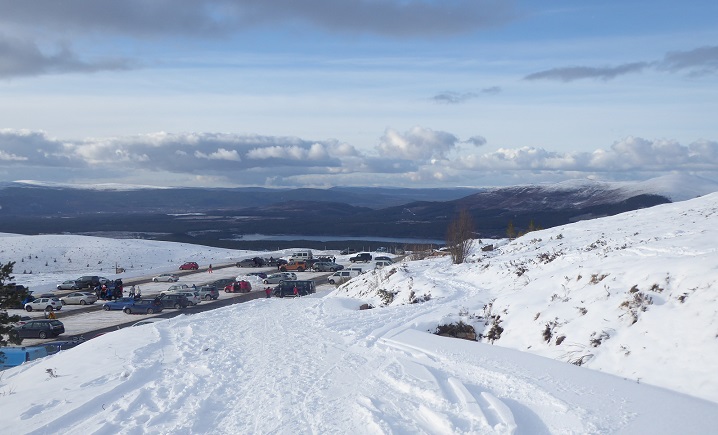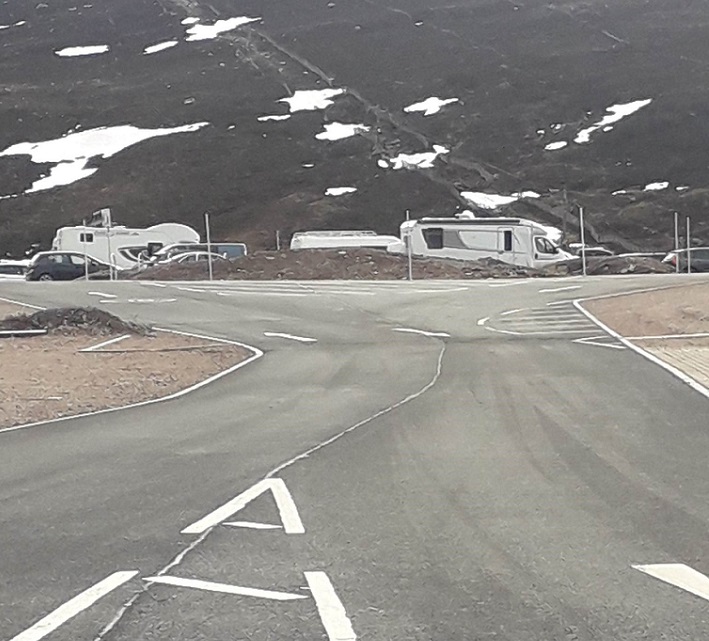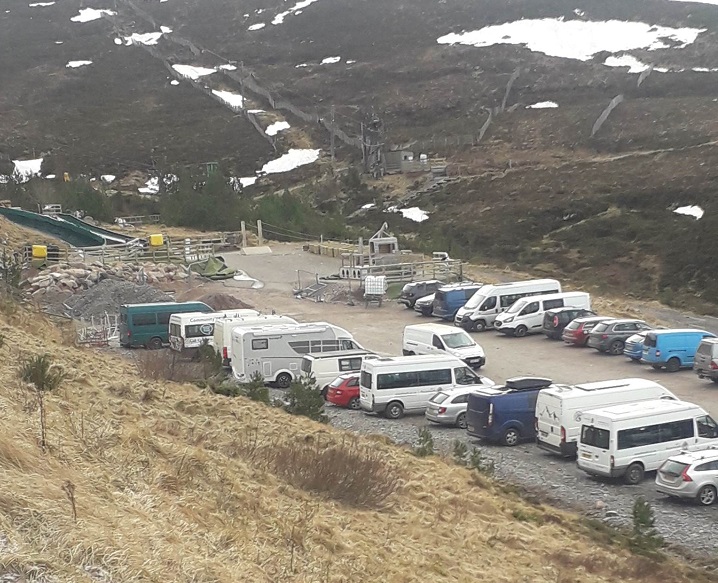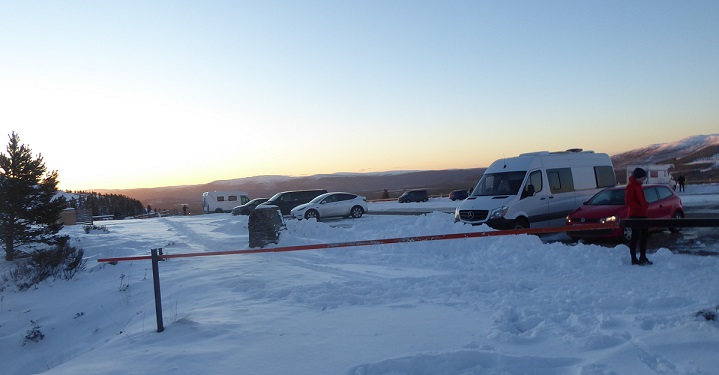
The snowsports season on Cairn Gorm came to an end on Sunday 16 April 2023. It wasn’t the best or worst of seasons, although the available parking capacity was exceeded on a number of occasions, particularly at mid-term in February.
During the course of the mid-term holiday in February, CairnGorm Mountain Scotland Ltd found it necessary to operate a shuttle bus service between the Ciste and Cas car parks. Mid-term is an exceptionally busy time period and it might have been expected that this service would be necessary. However, there was a lack of snow this year which curtailed the numbers on the hill. The Car park T-Bar, Ridge Poma, Daylodge Poma and the West Wall Poma were not able to operate due to the lack of snow during that peak trading period.
The as yet incomplete works to improve the upper Cas Car park and the newly laid out entrance/exit area has led to a reduction in the number of parking spaces.

The lower Cas carpark has also seen a permanent reduction in parking spaces due to the inclusion of kids adventure activities.

Climbers and walkers have been directed to the lower car park. Photo Credit: Alan Brattey February 2023
The result of the reduction in parking capacity in the Coire Cas car parks has meant that the hill business has to deploy shuttle buses even though the pistes are not busy.
An FOI request to CMSL revealed that the upper Cas car park should only lose 13 spaces when the car park upgrading works are finished (from 386 to 373 spaces). Adding in the loss of capacity from the lower Cas Car park does however mean that the hill business is less able to capitalise on the good snow conditions when the opportunity arises.
The halcyon days when over 30 buses, carrying dozens of people, would arrive at Cairn Gorm at the weekends are long gone (see here).

A frequent and reliable public bus service from Aviemore could help considerably.
Regrettably, such a service does not exist today, which is to the detriment to the hill business and the wider local tourism based economy. There is no service at all on Sundays and only two buses over the course of the day on Saturdays. the first of which (no 37) does not leave Aviemore until 9.25a.m. and the last is off the hill at 13.49p.m. On a Sunday THERE IS NO SERVICE! Even during the week, the first bus doesn’t arrive in the Cas Car park until about 9.30am and there are just six buses per day.
CairnGorm Mountain Scotland Ltd has a section in their website entitled ‘Getting here’ which says this, under Bus Service: ‘’Please be aware that the service is limited on Saturdays and there is currently no bus service on Sundays’’.
It is obvious that the lack of a public bus service can only be detrimental to Glenmore based businesses as well as to CairnGorm
There are proposals to ban vehicle parking along the side of Loch Morlich which would surely increase the usage of public buses, which also drop off and pick up passengers in Glenmore as well as at Cairn Gorm. A new bus can cost over £300K but anything would be better than nothing:

The Aviemore and Glenmore Community Trust have ambitions in respect of the provision of a local bus service. HIE should assist with the necessary start up capital funding – new electric buses? – and help the local community to further the service offered in the area for the benefit of tourists and locals alike. A bus would help employees get to work, instead of paying today’s high fuel prices which is making it difficult for CairnGorm to recruit staff, and reduce carbon emissions in the National Park.

Reduced parking capacity and greater reliance on shuttle buses strengthens the argument for providing customers with facilities within the Coire na Ciste car park. At the present time, there are no customer facilities provided there which makes for a very poor service offering. The Ciste building, which was thought to be fit only for demolition, is in fact generally sound and could be brought back to life, if the will was there to do that and provide customers with the service that they are entitled to expect.

The Aviemore and Glenmore Community Trust [AGCT] should be asked to take control of the Ciste car park, building and the Coire itself. These are virtually unused public assets which should be returning economic and other benefits to the local and wider communities.
The Cairngorm National Park Authority should be behind such Community Involvement. The aims of the National Park are:
- To conserve and enhance the natural and cultural heritage of the area
- To promote sustainable use of the natural resources of the area
- To promote understanding and enjoyment [including enjoyment in the form of recreation] of the special qualities of the area by the public
- To promote sustainable economic and social development of the area’s communities.
All of these aims are ticked off by the AGCT gaining ownership of the Ciste side of the mountain and developing it accordingly.
The Board of Directors of CMSL and HIE, together with stakeholder public bodies such as Highland Council, the CNPA and Nature Scot could be working with the AGCT to bring about these much needed improvements.

Aye, the current bus connectivity between Aviemore is just short of appalling. As usual the ‘bleedin obvious’ is being ignored by the politicians and bureaucrats
I live in Aviemore and would happily take the bus to avoid parking up the hill.
A tourist tax is much needed for the Cairngorms national park, 2 pound a night and give tourist a free bus pass for the national park. Provide free regular local buses between all the local villages/towns with regular 30 mins/1 hour buses to Cairngorm, even throw in a free ride on the funicular or at least a lift down. The tax wouldn’t cover the whole cost but the subsidy required wouldn’t run close to the cost of maintaining the funicular but would provide far more benefits to the local economy.
Some realism is required. Local bus operators who currently provide school transport across the highlands could inform how much it costs ( crew, fuel, taxes, admin, maintenance, depreciation), to keep each “small” bus on the smaller roads in any region. My one time industry involvement may by now be out of date…but should a figure well in excess of £150 even £200 an hour surprise ? From whatever figure, the cost of providing a hourly direct and return service to Cairngorm from Aviemore can be arrived at..for just one bus. How much is the present – rather inadequate?- service costing each day? Can anyone find the figures? The dream that a significant degree of penalty ( tax) on being a tourist in Scotland might be the answer to “funding” is a wild ride. Just how much would local tax of £2 or even £5 a night raise? and once re-administered by office staff and dispersed to worthy schemes is this total anywhere on the “same page” as the real costs say £800- £1k a day of providing little more than a skeleton service on a single bus unless it also is taking fares. Any tourist tax funding model would run the risk..of being far too intermittent to fund sufficient service at peak demand hours..far too large and costly with unnecessary capacity at others. Of course when running empty this is hugely fuel inefficient ? What the daily revenue from any local bed tax might be, is uncertain..with now way of knowing how much might be left over for funding buses for any other dreamy local aspiration? Reality -as ever – a very ‘hard master’.
Some interesting comments Tom. The major snag is that I doubt that any bus operator would provide figures in case someone started up in opposition, which is exactly what is being proposed here! What should be remembered is that when some consultancy back in the 1990’s told CML to concentrate on the core business, i.e. skiing, their asset stripping removed the very part of the business keeping the whole business financially viable! The lift company ran a successful bus company, as well as workers accommodation, which was then sold off! The new EKOS report for the S.G. is now saying diversification is necessary. A new bus service operated by CM(S)L? A workers hostel owned by CM(S)L? New uplift in the Ciste owned by CM(S)L? Sometimes the old ideas were the best.
I would never expect a tourist tax to cover the cost of free frequent free bus use within the Cairngorm national park, but it’s not really the point, subsidies it to however much it cost, run by a state owned bus operator. It works all over Europe, example would be Swiss saxony in Germany, most people travel there by train, it’s a similar size to Cairngorms and will get similar amount of visitors per year. Once your on holiday, all public transport within the National park is free, train, buses and ferries. Real easy to link up long point to point hikes with frequent buses. Everyone pays a small token tourist tax but most the cost covered by state to encourage sustainable tourism, it works no one drives and frequent buses are always busy. Can’t see how a similar scheme wouldn’t work here, https://www.saechsische-schweiz.de/en/explore/sustainable-holidays
And cost probably less than stated, once you own the fleet of buses the only real cost is fuel, maintenance and wages, can’t see it costing 1000 per hour per bus. The government already owns scotsrail so you might as well throw in free train travel between Pitlochry and carrbridge as well.
I’m sorry Daryl. Can you please explain why you think that the owner or owners of any bus should put it to use without prospect of a full economic return? Whether funded by grants, or funded by those who climb aboard, the routine expenses of having any bus on the road remain a fixed drain on the owner. (Insurance,road duty, commercial vehicle testing, tyres, routine maintenance, and then fuel and routine wear and tear.) Even if an under-used bus was somehow gifted, regulations exist. These specify how all PSV must be kept and held properly parked on an approved off road site. Would it were simpler…but it is simply unrealistic to think this type of service can be offered “for free” without massive support from treasury funds. ( incidentally the current costs to the treasury of issuing free bus pass concessions might be employed far better in order to to ensure enough forward-thinking maintenance was effective across the remoter highland area road system, to benefit of all users.) (Regarding the notion of a £1000 per hour bus..I suspect a typo )
The consultancy Stantec Ltd was commissioned by CNPA “to carry out a study exploring sustainable transport options for the Glenmore corridor”. In November 2022, an online consultation meeting (with a very small number of hillwalker participants, but maybe reasons for that) was held, and discussed various options such as better bus services (in various senses, e.g. frequency, timing, gear-carrying), selective road closures (ditto, e.g. seasonal, vehicle type, pricing), etc. THere may well have been other such meetings, and presumably Stantec have reported to the CNPA, or will do so. But I (as a consultee) have heard no more!